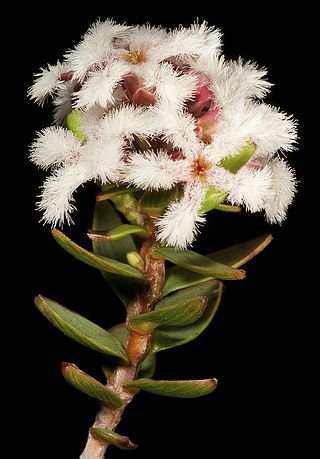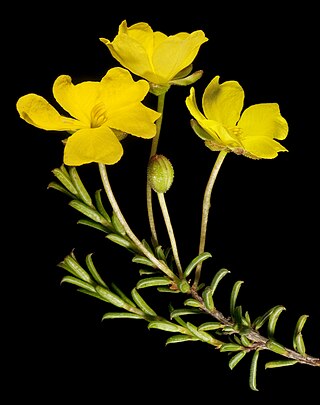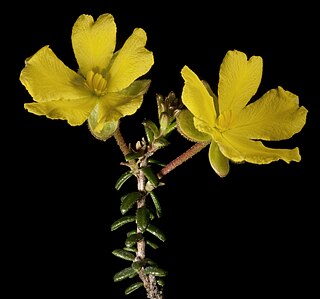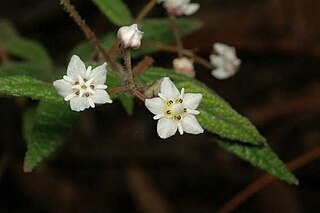
Seringia integrifolia, commonly known as common firebush, is a species of flowering plant in the family Malvaceae and endemic to the south-west of Western Australia. It is a compact shrub, its new growth densely covered with star-shaped hairs, and has mostly narrowly leaves and many deep blue to purple flowers arranged in groups of 4 to 10.

Seringia velutina, commonly known as velvet firebush, is a species of flowering plant in the family Malvaceae family and is endemic to the south-west of Western Australia. It is a suckering shrub that sometimes forms dense colonies. Its leaves are narrowly elliptic to egg-shaped and it has 3 to 11 pale pink to purple flowers arranged in loose cymes.

Thomasia angustifolia, commonly known as narrow-leaved thomasia, is a species of flowering plant in the family Malvaceae and is endemic to the south-west of Western Australia. It has densely hairy young stems, narrowly oblong, wrinkled leaves and pinkish-purple, bell-shaped flowers.

Leucopogon polymorphus is a species of flowering plant in the heath family Ericaceae and is endemic to near-coastal areas of south-western Western Australia. It is a shrub with egg-shaped to lance-shaped or almost linear leaves and short, dense spines of white, tube-shaped flowers.

Commersonia corniculata is a species of flowering plant in the family Malvaceae and is endemic to the southwest of Western Australia. It is an erect to prostrate shrub with 3-lobed, egg-shaped leaves, and white to cream-coloured flowers.

Hibbertia lineata is a species of flowering plant in the family Dilleniaceae and is endemic to the south-west of Western Australia. It is a spreading to erect shrub with linear to narrow egg-shaped leaves and yellow flowers, usually with ten stamens arranged on one side of, and leaning over the two densely hairy carpels.

Hibbertia microphylla is a species of flowering plant in the family Dilleniaceae and is endemic to the south-west of Western Australia. It is a shrub with weakly ascending stems, broadly egg-shaped to elliptic leaves and yellow flowers, usually with ten stamens and up to nine staminodes arranged on one side of, and leaning over the two densely hairy carpels.

Hibbertia striata is a species of flowering plant in the family Dilleniaceae and is endemic to the southwest of Western Australia. It is a spreading shrub with linear leaves and yellow flowers usually with thirty stamens arranged in five bundles around five glabrous carpels.
Lasiopetalum indutum is a species of flowering plant in the family Malvaceae and is endemic to the south-west of Western Australia. It is an erect or straggling shrub with hairy stems and pink, cream-coloured or white flowers.
Lasiopetalum membranaceum is a species of flowering plant in the family Malvaceae and is endemic to near-coastal areas of south-western Western Australia. It is an erect, spreading shrub or subshrub with hairy young stems, egg-shaped leaves and mauve-pink and dark red flowers.

Thomasia cognata is a species of flowering plant in the family Malvaceae and is endemic to the south-west of Western Australia. It is a compact, multi-stemmed shrub with wrinkled, narrowly oblong to elliptic leaves and pale pink flowers.
Thomasia discolor is a species of flowering plant in the family Malvaceae and is endemic to the south-west of Western Australia. It is a small, compact shrub with hairy new growth, heart-shaped leaves with wavy, lobed edges, and pink flowers in crowded clusters.
Thomasia × formosa is a species of flowering plant in the family Malvaceae and is endemic to a restricted area of the south-west of Western Australia. It is an erect, compact shrub with densely hairy branchlets, hairy, coarsely serrated, egg-shaped to elliptic or oblong leaves, and racemes of pink or purple flowers arranged in leaf axils.
Thomasia montana, commonly known as hill thomasia, is a species of flowering plant in the family Malvaceae and is endemic to the south-west of Western Australia. It is an upright to low, ground-covering shrub with hairy new growth, egg-shaped to broadly oblong leaves, sometimes with wavy or toothed edges, and pale purplish-pink to maroon flowers.
Cryptandra nutans is a species of flowering plant in the family Rhamnaceae and is endemic to the southwest of Western Australia. It is a shrub that typically grows to a height of 10–60 cm (3.9–23.6 in) and has many stems at ground level. Its leaves are up to 4 mm (0.16 in) long, and the flowers are white, pink or cream-coloured and crowded in spikes on the ends of branches. The sepals are joined at the base to form a broadly bell-shaped tube, less than 2 mm (0.079 in) long with spreading lobes. Flowering occurs in August and September. It was first formally described in 1845 by Ernst Gottlieb von Steudel in Lehmann's Plantae Preissianae from specimens collected in 1840. The specific epithet (nutans) means "nodding".
Stenanthemum tridentatum is a species of flowering plant in the family Rhamnaceae and is endemic to the southwest of Western Australia. It is a prostrate to upright shrub with sparsely hairy young stems, egg-shaped to fan-shaped leaves, and creamy white or creamy-yellow flowers arranged singly or in groups of up to three.
Thomasia rulingioides is a species of flowering plant in the family Malvaceae and is endemic to the south-west of Western Australia. It is an erect, open shrub with densely hairy new growth, narrowly oblong to narrowly egg-shaped leaves with wavy edges, and pink to purple flowers.

Commersonia rugosa is a species of flowering plant in the family Malvaceae and endemic to New South Wales. It is an open, straggly shrub with linear to narrowly egg-shaped leaves with irregular teeth or lobes on the edges, and white flowers in clusters of 3 to 15.
Pimelea villifera is a species of flowering plant in the family Thymelaeaceae and is endemic to the south-west of Western Australia. It is an erect, dense shrub usually with linear to narrowly elliptic leaves arranged in opposite pairs, and compact heads of many white flowers usually surrounded by 6 to 10 pairs of green and yellowish, narrowly egg-shaped involucral bracts.

Guichenotia micrantha, commonly known as small flowered guichenotia, is a species of flowering plant in the family Malvaceae and is endemic to the south-west of Western Australia. It is a low, compact shrub with linear to narrowly egg-shaped leaves and pink flowers in groups of three to six.











